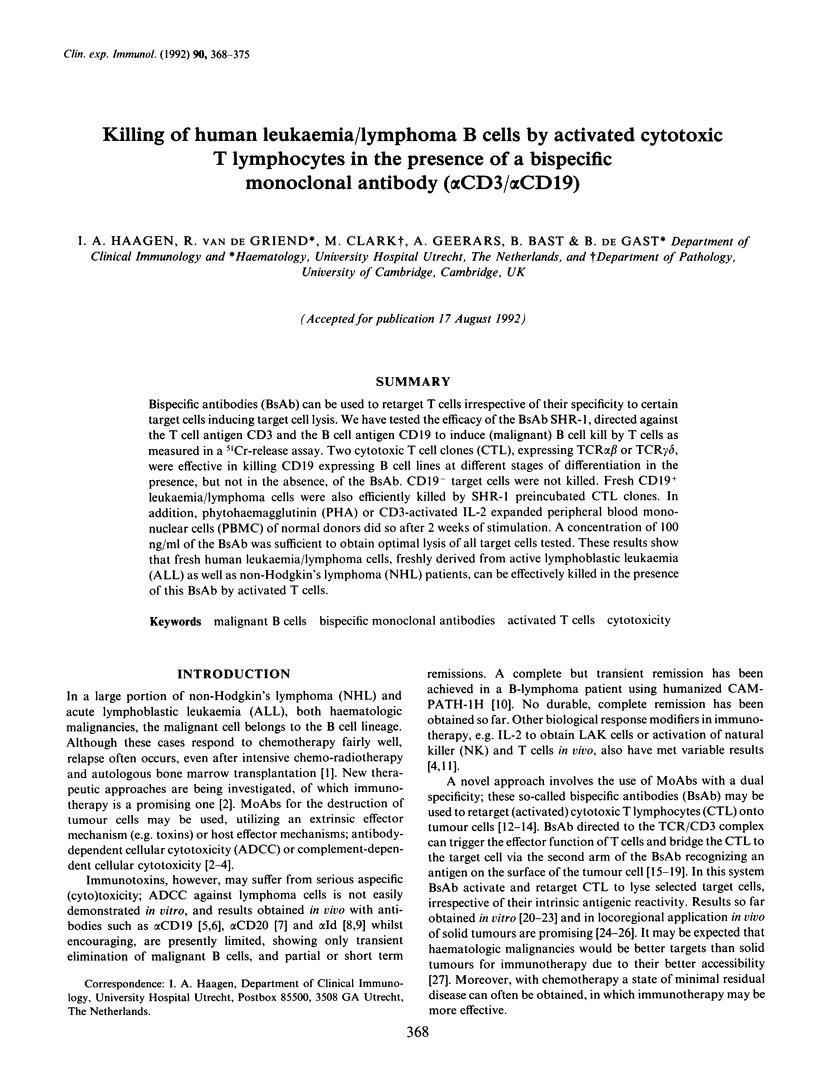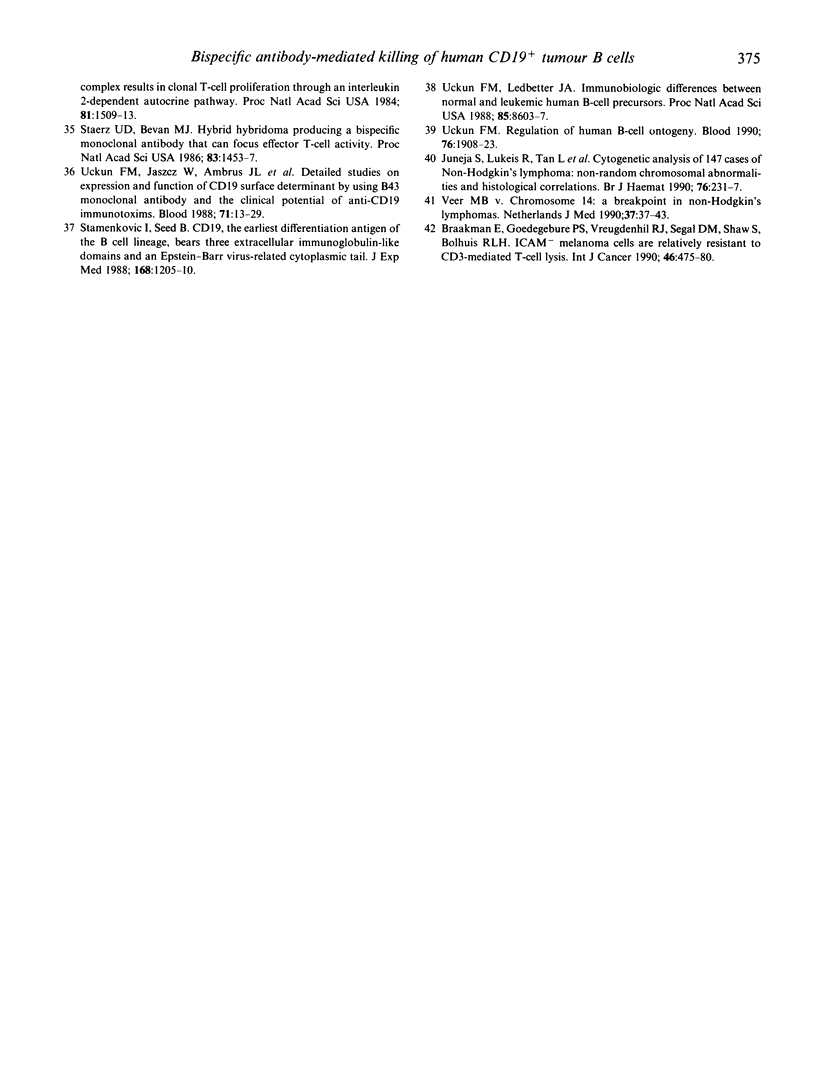Abstract
Bispecific antibodies (BsAb) can be used to retarget T cells irrespective of their specificity to certain target cells inducing target cell lysis. We have tested the efficacy of the BsAb SHR-1, directed against the T cell antigen CD3 and the B cell antigen CD19 to induce (malignant) B cell kill by T cells as measured in a 51Cr-release assay. Two cytotoxic T cell clones (CTL), expressing TCR alpha beta or TCR gamma delta, were effective in killing CD19 expressing B cell lines at different stages of differentiation in the presence, but not in the absence, of the BsAb. CD19- target cells were not killed. Fresh CD19+ leukaemia/lymphoma cells were also efficiently killed by SHR-1 preincubated CTL clones. In addition, phytohaemagglutinin (PHA) or CD3-activated IL-2 expanded peripheral blood mononuclear cells (PBMC) of normal donors did so after 2 weeks of stimulation. A concentration of 100 ng/ml of the BsAb was sufficient to obtain optimal lysis of all target cells tested. These results show that fresh human leukaemia/lymphoma cells, freshly derived from active lymphoblastic leukaemia (ALL) as well as non-Hodgkin's lymphoma (NHL) patients, can be effectively killed in the presence of this BsAb by activated T cells.
Full text
PDF







Selected References
These references are in PubMed. This may not be the complete list of references from this article.
- Allebes W., Knops R., Herold M., Huber C., Haanen C., Capel P. Immunotherapy with monoclonal anti-idiotypic antibodies: tumour reduction and lymphokine production. Leuk Res. 1991;15(4):215–222. doi: 10.1016/0145-2126(91)90123-b. [DOI] [PubMed] [Google Scholar]
- Barr I. G., MacDonald H. R., Buchegger F., von Fliedner V. Lysis of tumor cells by the retargeting of murine cytolytic T lymphocytes with bispecific antibodies. Int J Cancer. 1987 Sep 15;40(3):423–429. doi: 10.1002/ijc.2910400323. [DOI] [PubMed] [Google Scholar]
- Barr I. G., Miescher S., von Fliedner V., Buchegger F., Barras C., Lanzavecchia A., Mach J. P., Carrel S. In vivo localization of a bispecific antibody which targets human T lymphocytes to lyse human colon cancer cells. Int J Cancer. 1989 Mar 15;43(3):501–507. doi: 10.1002/ijc.2910430327. [DOI] [PubMed] [Google Scholar]
- Braakman E., Goedegebuure P. S., Vreugdenhil R. J., Segal D. M., Shaw S., Bolhuis R. L. ICAM- melanoma cells are relatively resistant to CD3-mediated T-cell lysis. Int J Cancer. 1990 Sep 15;46(3):475–480. doi: 10.1002/ijc.2910460325. [DOI] [PubMed] [Google Scholar]
- Brown S. L., Miller R. A., Horning S. J., Czerwinski D., Hart S. M., McElderry R., Basham T., Warnke R. A., Merigan T. C., Levy R. Treatment of B-cell lymphomas with anti-idiotype antibodies alone and in combination with alpha interferon. Blood. 1989 Feb 15;73(3):651–661. [PubMed] [Google Scholar]
- Clark M. R., Waldmann H. T-cell killing of target cells induced by hybrid antibodies: comparison of two bispecific monoclonal antibodies. J Natl Cancer Inst. 1987 Dec;79(6):1393–1401. [PubMed] [Google Scholar]
- Clark M., Bindon C., Dyer M., Friend P., Hale G., Cobbold S., Calne R., Waldmann H. The improved lytic function and in vivo efficacy of monovalent monoclonal CD3 antibodies. Eur J Immunol. 1989 Feb;19(2):381–388. doi: 10.1002/eji.1830190224. [DOI] [PubMed] [Google Scholar]
- Fanger M. W., Segal D. M., Romet-Lemonne J. L. Bispecific antibodies and targeted cellular cytotoxicity. Immunol Today. 1991 Feb;12(2):51–54. doi: 10.1016/0167-5699(91)90156-N. [DOI] [PubMed] [Google Scholar]
- Ferrini S., Melioli G., Moretta L. Immunotherapy and immunity to cancer: cellular mechanisms. Curr Opin Immunol. 1989;2(5):683–688. doi: 10.1016/0952-7915(90)90030-k. [DOI] [PubMed] [Google Scholar]
- Foon K. A. Biological response modifiers: the new immunotherapy. Cancer Res. 1989 Apr 1;49(7):1621–1639. [PubMed] [Google Scholar]
- Friend P. J. Immunosuppression with monoclonal antibodies. Curr Opin Immunol. 1989;2(6):859–863. doi: 10.1016/0952-7915(89)90170-2. [DOI] [PubMed] [Google Scholar]
- Gillies S. D., Wesolowski J. S., Lo K. M. Targeting human cytotoxic T lymphocytes to kill heterologous epidermal growth factor receptor-bearing tumor cells. Tumor-infiltrating lymphocyte/hormone receptor/recombinant antibody. J Immunol. 1991 Feb 1;146(3):1067–1071. [PubMed] [Google Scholar]
- Hale G., Dyer M. J., Clark M. R., Phillips J. M., Marcus R., Riechmann L., Winter G., Waldmann H. Remission induction in non-Hodgkin lymphoma with reshaped human monoclonal antibody CAMPATH-1H. Lancet. 1988 Dec 17;2(8625):1394–1399. doi: 10.1016/s0140-6736(88)90588-0. [DOI] [PubMed] [Google Scholar]
- Hekman A., Honselaar A., Vuist W. M., Sein J. J., Rodenhuis S., ten Bokkel Huinink W. W., Somers R., Rümke P., Melief C. J. Initial experience with treatment of human B cell lymphoma with anti-CD19 monoclonal antibody. Cancer Immunol Immunother. 1991;32(6):364–372. doi: 10.1007/BF01741331. [DOI] [PMC free article] [PubMed] [Google Scholar]
- Jaffe E. S. The role of immunophenotypic markers in the classification of non-Hodgkin's lymphomas. Semin Oncol. 1990 Feb;17(1):11–19. [PubMed] [Google Scholar]
- Jain R. K. Vascular and interstitial barriers to delivery of therapeutic agents in tumors. Cancer Metastasis Rev. 1990 Nov;9(3):253–266. doi: 10.1007/BF00046364. [DOI] [PubMed] [Google Scholar]
- Juneja S., Lukeis R., Tan L., Cooper I., Szelag G., Parkin J. D., Ironside P., Garson O. M. Cytogenetic analysis of 147 cases of non-Hodgkin's lymphoma: non-random chromosomal abnormalities and histological correlations. Br J Haematol. 1990 Oct;76(2):231–237. doi: 10.1111/j.1365-2141.1990.tb07877.x. [DOI] [PubMed] [Google Scholar]
- Jung G., Eberhard H. J. An in-vitro model for tumor immunotherapy with antibody heteroconjugates. Immunol Today. 1988 Sep;9(9):257–260. doi: 10.1016/0167-5699(88)91304-7. [DOI] [PubMed] [Google Scholar]
- Lanzavecchia A., Scheidegger D. The use of hybrid hybridomas to target human cytotoxic T lymphocytes. Eur J Immunol. 1987 Jan;17(1):105–111. doi: 10.1002/eji.1830170118. [DOI] [PubMed] [Google Scholar]
- Meuer S. C., Hussey R. E., Cantrell D. A., Hodgdon J. C., Schlossman S. F., Smith K. A., Reinherz E. L. Triggering of the T3-Ti antigen-receptor complex results in clonal T-cell proliferation through an interleukin 2-dependent autocrine pathway. Proc Natl Acad Sci U S A. 1984 Mar;81(5):1509–1513. doi: 10.1073/pnas.81.5.1509. [DOI] [PMC free article] [PubMed] [Google Scholar]
- Nelson H. Targeted cellular immunotherapy with bifunctional antibodies. Cancer Cells. 1991 May;3(5):163–172. [PubMed] [Google Scholar]
- Nitta T., Sato K., Okumura K., Ishii S. Induction of cytotoxicity in human T cells coated with anti-glioma x anti-CD3 bispecific antibody against human glioma cells. J Neurosurg. 1990 Mar;72(3):476–481. doi: 10.3171/jns.1990.72.3.0476. [DOI] [PubMed] [Google Scholar]
- Nitta T., Sato K., Yagita H., Okumura K., Ishii S. Preliminary trial of specific targeting therapy against malignant glioma. Lancet. 1990 Feb 17;335(8686):368–371. doi: 10.1016/0140-6736(90)90205-j. [DOI] [PubMed] [Google Scholar]
- Perez P., Hoffman R. W., Shaw S., Bluestone J. A., Segal D. M. Specific targeting of cytotoxic T cells by anti-T3 linked to anti-target cell antibody. Nature. 1985 Jul 25;316(6026):354–356. doi: 10.1038/316354a0. [DOI] [PubMed] [Google Scholar]
- Press O. W., Appelbaum F., Ledbetter J. A., Martin P. J., Zarling J., Kidd P., Thomas E. D. Monoclonal antibody 1F5 (anti-CD20) serotherapy of human B cell lymphomas. Blood. 1987 Feb;69(2):584–591. [PubMed] [Google Scholar]
- Pupa S. M., Canevari S., Fontanelli R., Ménard S., Mezzanzanica D., Lanzavecchia A., Colnaghi M. I. Activation of mononuclear cells to be used for hybrid monoclonal antibody-induced lysis of human ovarian carcinoma cells. Int J Cancer. 1988 Sep 15;42(3):455–459. doi: 10.1002/ijc.2910420324. [DOI] [PubMed] [Google Scholar]
- Sosman J. A., Hank J. A., Sondel P. M. In vivo activation of lymphokine-activated killer activity with interleukin-2: prospects for combination therapies. Semin Oncol. 1990 Feb;17(1 Suppl 1):22–41. [PubMed] [Google Scholar]
- Staerz U. D., Bevan M. J. Hybrid hybridoma producing a bispecific monoclonal antibody that can focus effector T-cell activity. Proc Natl Acad Sci U S A. 1986 Mar;83(5):1453–1457. doi: 10.1073/pnas.83.5.1453. [DOI] [PMC free article] [PubMed] [Google Scholar]
- Staerz U. D., Kanagawa O., Bevan M. J. Hybrid antibodies can target sites for attack by T cells. Nature. 1985 Apr 18;314(6012):628–631. doi: 10.1038/314628a0. [DOI] [PubMed] [Google Scholar]
- Stamenkovic I., Seed B. CD19, the earliest differentiation antigen of the B cell lineage, bears three extracellular immunoglobulin-like domains and an Epstein-Barr virus-related cytoplasmic tail. J Exp Med. 1988 Sep 1;168(3):1205–1210. doi: 10.1084/jem.168.3.1205. [DOI] [PMC free article] [PubMed] [Google Scholar]
- Titus J. A., Perez P., Kaubisch A., Garrido M. A., Segal D. M. Human K/natural killer cells targeted with hetero-cross-linked antibodies specifically lyse tumor cells in vitro and prevent tumor growth in vivo. J Immunol. 1987 Nov 1;139(9):3153–3158. [PubMed] [Google Scholar]
- Uckun F. M., Jaszcz W., Ambrus J. L., Fauci A. S., Gajl-Peczalska K., Song C. W., Wick M. R., Myers D. E., Waddick K., Ledbetter J. A. Detailed studies on expression and function of CD19 surface determinant by using B43 monoclonal antibody and the clinical potential of anti-CD19 immunotoxins. Blood. 1988 Jan;71(1):13–29. [PubMed] [Google Scholar]
- Uckun F. M., Ledbetter J. A. Immunobiologic differences between normal and leukemic human B-cell precursors. Proc Natl Acad Sci U S A. 1988 Nov;85(22):8603–8607. doi: 10.1073/pnas.85.22.8603. [DOI] [PMC free article] [PubMed] [Google Scholar]
- Uckun F. M. Regulation of human B-cell ontogeny. Blood. 1990 Nov 15;76(10):1908–1923. [PubMed] [Google Scholar]
- van 't Veer M. B. Chromosome 14: a breakpoint in non-Hodgkin's lymphomas. Neth J Med. 1990 Aug;37(1-2):37–43. [PubMed] [Google Scholar]
- van de Griend R. J., Bolhuis R. L. Rapid expansion of allospecific cytotoxic T cell clones using nonspecific feeder cell lines without further addition of exogenous IL2. Transplantation. 1984 Oct;38(4):401–406. doi: 10.1097/00007890-198410000-00017. [DOI] [PubMed] [Google Scholar]
- van de Griend R. J., Giphart M. J., Van Krimpen B. A., Bolhuis R. L. Human T cell clones exerting multiple cytolytic activities show heterogeneity in susceptibility to inhibition by monoclonal antibodies. J Immunol. 1984 Sep;133(3):1222–1229. [PubMed] [Google Scholar]


